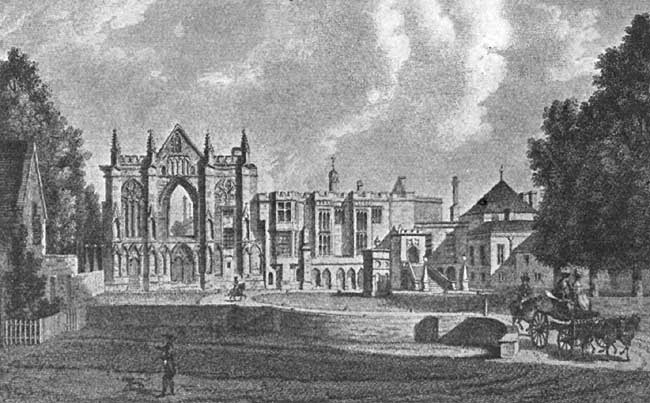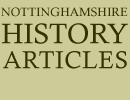
Newstead Abbey, an Engraving from the Drawing by Paul Sandby.
Thomas and his younger brother Paul Sandby both come within the category of Topographical artists, and while the elder was more concerned with his architectural work, Paul also belongs to the landscapists in the wider application of the term.
Both were Nottinghamshire men, born in the County Town, their father hailing from the village of Babworth, near Retford. Their first drawings were made among the streets of the old town, and both in due course passed into the Military Drawing Office at the Tower of London, Thomas becoming Private Secretary and Draughtsman to H.R.H. William Augustus, Duke of Cumberland, and in this capacity seeing active service both in Flanders and in Scotland, before settling down in his appointment of Deputy Ranger of Windsor Great Park. Paul, after some five years with the survey, joined his brother for a time in the work of laying out Virginia Water. He was later appointed Chief Drawing Master at the Royal Military Academy of Woolwich. Both brothers were among the Foundation Members of the Royal Academy, Thomas being elected to the Chair of Architecture.
Paul was a very prolific worker, and published many of his own plates, using the Aquatint method of engraving for most of these, though there are a good many etchings also to his credit. He did much to encourage younger men and gathered about him a wide circle of friends who made a habit of visiting his house on Sundays after church.
Though his pencil was occupied wherever he went, and his travels in the British Isles are extensive, there are not many views connected with his native county to his credit. Plates of Nottingham Castle engraved by his pupil, William Watts, were published in 1776, the "Newstead Priory, Nottinghamshire," here reproduced, is dated three years later (October, 1779), and bears the names of two engravers—W. Walker and W. Angus.
It may be noted that both the Sandby brothers lived beyond the allotted three score years and ten, Thomas reaching the age of 77, and Paul being 84 when he died in 1809.
The process of Aquatint engraving, which Paul Sandby first used in England, and which he did much to perfect, was one of the greatest assets of the Topographical artist, permitting of very delicate renditions of his drawings. Indeed, many of these aquatints are things to delight in, quite apart from any interest they may have as records of past scenes. The medium permitted of very subtle variations in tone, and further lent itself to the introduction of colour, a practice frequently resorted to. Nearly all the prints which bear the name of Richard Bonington (father of the renowned Richard Parkes Bonington) are produced by this method, though apart from two views of Sheffield, they are more particularly of Nottingham interest. It was also used by Havel to reproduce the local views of Bonington's contemporary and fellow townsman, Thomas Barber, though the latter is better known for his portraits, which include many of the most important county people of his time.
Lithography, introduced in the early part of last century, was another means of reproduction which served to popularize Topographical works—further, by permitting the artist himself to work direct upon the stone or transfer paper, it gave a perfect rendering of the drawing so made. Thus, it made a particular appeal to some men, and among those may be mentioned Rawson Walker, another Nottingham artist, who showed a penchant for working in black-and-white.
About a century ago there came into being the Steel-Engraving, so-called because steel plates were used in place of the copper sheets hitherto in use. From a technical point of view, it permitted the cutting of very fine lines and the hard surface allowed large numbers of prints to be made from the same plate without apparent deterioration in their quality. Its eventual decline, from an artistic point of view, was brought about by the introduction of mechanical devices for the production of the plate with the consequent lack of all individuality or sense of expression.
One effect it had immediately was that of bringing within the bounds of possibility issues of illustrated works on a scale hitherto out of the question.
Much delightful work was produced in this manner and the plates by J. W. Lowry, T. H. Prior, and others from the works of Tom Allom, may be numbered among the best of the period.
Thomas Allom was born in 1804, and trained as an architect under Francis Goodwin, working as a pupil upon such diverse undertakings as Derby Gaol, the Manchester Town Hall and the Church of West Bromwich. Such was the quality of his work that the House of Commons ordered his designs for the Houses of Parliament to be lithographed. It may be added that he was one of the founders of the Society of Architects. It was through a wish to gain a greater knowledge of his profession that he began his travels and the painting of views. He journeyed East, working in Asia Minor and Constantinople, as well as under the patronage of Louis-Phillipe, in France.
